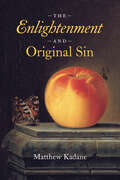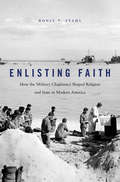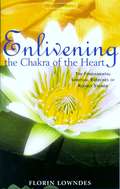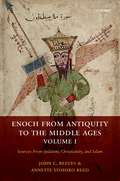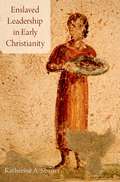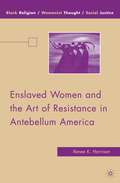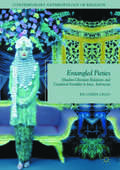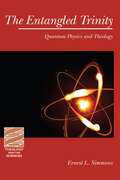- Table View
- List View
Enlightenment and Modernity: The English Deists and Reform (The Enlightenment World)
by Wayne HudsonThe writers known as the English deists were not simply religious controversialists, but agents of reform who contributed to the emergence of modernity. This title claims that these writers advocated a failed ideology which itself declined after 1730. It argues for an evolution of their ideas into a more modern form.
Enlightenment and Modernity: The English Deists and Reform (The Enlightenment World #13)
by Wayne HudsonThe writers known as the English deists were not simply religious controversialists, but agents of reform who contributed to the emergence of modernity. This title claims that these writers advocated a failed ideology which itself declined after 1730. It argues for an evolution of their ideas into a more modern form.
The Enlightenment and Original Sin (The Life of Ideas)
by Matthew KadaneAn eloquent microhistory that argues for the centrality of the doctrine of original sin to the Enlightenment. What was the Enlightenment? This question has been endlessly debated. In The Enlightenment and Original Sin, historian Matthew Kadane advances the bold claim that the Enlightenment is best defined through what it set out to accomplish, which was nothing short of rethinking the meaning of human nature. Kadane argues that this project centered around the doctrine of original sin and, ultimately, its rejection, signaling the radical notion that an inherently flawed nature can be overcome by human means. Kadane explores this and other wide-ranging themes through the story of a previously unknown figure, Pentecost Barker, an eighteenth-century purser and wine merchant. By examining Barker’s personal diary and extensive correspondence with a Unitarian minister, Kadane tracks the transformation of Barker’s consciousness from a Puritan to an Enlightenment outlook, revealing through one man’s journey the large-scale shifts in self-understanding whose philosophical reverberations have shaped debates on human nature for centuries.
The Enlightenment Bible: Translation, Scholarship, Culture
by Jonathan SheehanHow did the Bible survive the Enlightenment? In this book, Jonathan Sheehan shows how Protestant translators and scholars in the eighteenth century transformed the Bible from a book justified by theology to one justified by culture. In doing so, the Bible was made into the cornerstone of Western heritage and invested with meaning, authority, and significance even for a secular age. The Enlightenment Bible offers a new history of the Bible in the century of its greatest crisis and, in turn, a new vision of this century and its effects on religion. Although the Enlightenment has long symbolized the corrosive effects of modernity on religion, Sheehan shows how the Bible survived, and even thrived in this cradle of ostensible secularization. Indeed, in eighteenth-century Protestant Europe, biblical scholarship and translation became more vigorous and culturally significant than at any time since the Reformation. From across the theological spectrum, European scholars--especially German and English--exerted tremendous energies to rejuvenate the Bible, reinterpret its meaning, and reinvest it with new authority. Poets, pedagogues, philosophers, literary critics, philologists, and historians together built a post-theological Bible, a monument for a new religious era. These literati forged the Bible into a cultural text, transforming the theological core of the Judeo-Christian tradition. In the end, the Enlightenment gave the Bible the power to endure the corrosive effects of modernity, not as a theological text but as the foundation of Western culture.
Enlightenment in Dispute: The Reinvention of Chan Buddhism in Seventeenth-Century China
by Jiang WuEnlightenment in Dispute is the first comprehensive study of the revival of Chan Buddhism in seventeenth-century China. Focusing on the evolution of a series of controversies about Chan enlightenment, Jiang Wu describes the process by which Chan reemerged as the most prominent Buddhist establishment of the time. He investigates the development of Chan Buddhism in the seventeenth century, focusing on controversies involving issues such as correct practice and lines of lineage. In this way, he shows how the Chan revival reshaped Chinese Buddhism in late imperial China. Situating these controversies alongside major events of the fateful Ming-Qing transition, Wu shows how the rise and fall of Chan Buddhism was conditioned by social changes in the seventeenth century.
Enlightenment in Dispute: The Reinvention of Chan Buddhism in Seventeenth-Century China
by Jiang WuEnlightenment in Dispute is the first comprehensive study of the revival of Chan Buddhism in seventeenth-century China. Focusing on the evolution of a series of controversies about Chan enlightenment, Jiang Wu describes the process by which Chan reemerged as the most prominent Buddhist establishment of the time. He investigates the development of Chan Buddhism in the seventeenth century, focusing on controversies involving issues such as correct practice and lines of lineage. In this way, he shows how the Chan revival reshaped Chinese Buddhism in late imperial China. Situating these controversies alongside major events of the fateful Ming-Qing transition, Wu shows how the rise and fall of Chan Buddhism was conditioned by social changes in the seventeenth century.
Enlising Faith: How the Military Chaplaincy Shaped Religion and State in Modern America
by Ronit Y. StahlRonit Stahl traces the ways the U.S. military struggled with, encouraged, and regulated religious pluralism and scrambled to handle the nation’s deep religious, racial, and political complexity. Just as the state relied on religion to sanction combat missions and sanctify war deaths, so too did religious groups seek validation as American faiths.
Enlising Faith: How the Military Chaplaincy Shaped Religion and State in Modern America
by Ronit Y. StahlRonit Stahl traces the ways the U.S. military struggled with, encouraged, and regulated religious pluralism and scrambled to handle the nation’s deep religious, racial, and political complexity. Just as the state relied on religion to sanction combat missions and sanctify war deaths, so too did religious groups seek validation as American faiths.
Enlivening the Chakra of the Heart: The Fundamental Spiritual Exercises of Rudolf Steiner
by Florin LowndesThe seer and teacher Rudolf Steiner advised that specific 'accompanying' or 'fundamental' spiritual exercises should always be carried out in conjunction with meditation. While meditation is the foundation of any spiritual path of development, it can pose dangers to normal consciousness. These exercises offer a protection, by helping to develop inner certainty and strength. This is achieved, for example, through the first exercise by concentrating and intensifying the powers of thinking, through the second by developing the control of the will, through the third by mastering the outer expressions of the life of feeling, and so on. Florin Lowndes describes the fundamental exercises in thorough detail, giving suggestions as to how they may be carried out. He also relates an important and hidden aspect - that the exercises embody the means for developing and strengthening organic and 'living' thinking, which is intimately related to the enlivening of a new organ of perception: the heart chakra or lotus. Lowndes casts new light on many aspects of this question, and offers encouragement and stimulus to those seeking a modern path of spiritual development. FLORIN LOWNDES was born in Romania in 1938 and had an international career in architectural art and design. In 1970 he emigrated to the United States, where he taught at college level and in Steiner Waldorf schools. Since 1971 he has been engaged in the study of anthroposophy, and has written many articles for journals on related questions. He co-authored The Human Life, and founded the Center of Heart-Thinking in Boston. At present he leads training seminars in the United States and throughout Europe.
The Enneagram and Spiritual Culture: Nine Paths to Spiritual Guidance
by James Empereur"[O]ffers a thourough, non-clinical reference for anyone who companions or is companioned on the spiritual way. Its concrete examples and clear style make its message accessible to readers whether or not they have previously heard of the enneagram." -Suzanne Zuercher
Enoch from Antiquity to the Middle Ages, Volume I: Sources From Judaism, Christianity, and Islam
by John C. Reeves Annette Yoshiko ReedAcross the ancient and medieval literature of Judaism, Christianity, and Islam, one finds references to the antediluvian sage Enoch. Both the Book of the Watchers and the Astronomical Book were long known from their Ethiopic versions, which are preserved as part of Mashafa Henok Nabiy ('Book of Enoch the Prophet')—an Enochic compendium known in the West as 1 Enoch. Since the discovery of Aramaic fragments among the Dead Sea Scrolls, these books have attracted renewed attention as important sources for ancient Judaism. Among the results has been the recognition of the surprisingly long and varied tradition surrounding Enoch. Within 1 Enoch alone, for instance, we find evidence for intensive literary creativity. This volume provides a comprehensive set of core references for easy and accessible consultation. It shows that the rich afterlives of Enochic texts and traditions can be studied more thoroughly by scholars of Second Temple Judaism and early Christianity as well as by scholars of late antique and medieval religions. Specialists in the Second Temple period-the era in which Enochic literature first appears-will be able to trace (or discount) the survival of Enochic motifs and mythemes within Jewish literary circles from late antiquity into the Middle Ages, thereby shedding light on the trajectories of Jewish apocalypticism and its possible intersections with Jewish mysticism. Students of Near Eastern esotericism and Hellenistic philosophies will have further data for exploring the origins of 'gnosticism' and its possible impact upon sectarian currents in Judaism, Christianity, and Islam. Those interested in the intellectual symbiosis among Jews, Christians, and Muslims in the Middle Ages-and especially in the transmission of the ancient sciences associated with Hermeticism (e.g., astrology, theurgy, divinatory techniques, alchemy, angelology, demonology)-will be able to view a chain of tradition reconstructed in its entirety for the first time in textual form. In the process, we hope to provide historians of religion with a new tool for assessing the intertextual relationships between different religious corpora and for understanding the intertwined histories of the major religious communities of the ancient and medieval Near East.
Enoch from Antiquity to the Middle Ages, Volume I: Sources From Judaism, Christianity, and Islam
by John Reeves Annette Yoshiko ReedAcross the ancient and medieval literature of Judaism, Christianity, and Islam, one finds references to the antediluvian sage Enoch. Both the Book of the Watchers and the Astronomical Book were long known from their Ethiopic versions, which are preserved as part of Mashafa Henok Nabiy ('Book of Enoch the Prophet')—an Enochic compendium known in the West as 1 Enoch. Since the discovery of Aramaic fragments among the Dead Sea Scrolls, these books have attracted renewed attention as important sources for ancient Judaism. Among the results has been the recognition of the surprisingly long and varied tradition surrounding Enoch. Within 1 Enoch alone, for instance, we find evidence for intensive literary creativity. This volume provides a comprehensive set of core references for easy and accessible consultation. It shows that the rich afterlives of Enochic texts and traditions can be studied more thoroughly by scholars of Second Temple Judaism and early Christianity as well as by scholars of late antique and medieval religions. Specialists in the Second Temple period-the era in which Enochic literature first appears-will be able to trace (or discount) the survival of Enochic motifs and mythemes within Jewish literary circles from late antiquity into the Middle Ages, thereby shedding light on the trajectories of Jewish apocalypticism and its possible intersections with Jewish mysticism. Students of Near Eastern esotericism and Hellenistic philosophies will have further data for exploring the origins of 'gnosticism' and its possible impact upon sectarian currents in Judaism, Christianity, and Islam. Those interested in the intellectual symbiosis among Jews, Christians, and Muslims in the Middle Ages-and especially in the transmission of the ancient sciences associated with Hermeticism (e.g., astrology, theurgy, divinatory techniques, alchemy, angelology, demonology)-will be able to view a chain of tradition reconstructed in its entirety for the first time in textual form. In the process, we hope to provide historians of religion with a new tool for assessing the intertextual relationships between different religious corpora and for understanding the intertwined histories of the major religious communities of the ancient and medieval Near East.
Enslaved Leadership in Early Christianity
by Dr. Katherine A. ShanerEnslaved persons were ubiquitous in the first- and second-century CE Roman Empire, and early Christian texts reflect this fact. Yet the implications of enslaved presence in religious practices are under-examined in early Christian and Roman history. Enslaved Leadership in Early Christianity argues that enslaved persons' roles in civic and religious activities were contested in many religious groups throughout ancient cities, including communities connected with Paul's legacy. This power struggle emerges as the book examines urban spaces, inscriptions, images, and literature from ancient Ephesos and its environs. Enslaved Leadership breaks new ground in analyzing archaeology and texts-asking how each attempts to persuade viewers, readers, and inhabitants of the city. Thus this book paints a complex picture of enslaved life in Asia Minor, a picture that illustrates how enslaved persons enacted roles of religious and civic significance that potentially upended social hierarchies privileging wealthy, slave-holding men. Enslaved persons were religious specialists, priests, and leaders in cultic groups, including early Christian groups. Yet even as the enslaved engaged in such authoritative roles, Roman slavery was not a benign institution nor were all early Christians kinder and more egalitarian to slaves. Both early Christian texts (such as Philemon,1 Timothy, Ignatius' letters) and the archaeological finds from Asia Minor defend, construct, and clarify the hierarchies that kept enslaved persons under the control of their masters. Enslaved Leadership illustrates a historical world in which control of slaves must continually be asserted. Yet this assertion of control raises a question: Why does enslaved subordination need to be so frequently re-established, particularly through violence, the threat of social death, and assertions of subordination?
Enslaved Leadership in Early Christianity
by Dr. Katherine A. ShanerEnslaved persons were ubiquitous in the first- and second-century CE Roman Empire, and early Christian texts reflect this fact. Yet the implications of enslaved presence in religious practices are under-examined in early Christian and Roman history. Enslaved Leadership in Early Christianity argues that enslaved persons' roles in civic and religious activities were contested in many religious groups throughout ancient cities, including communities connected with Paul's legacy. This power struggle emerges as the book examines urban spaces, inscriptions, images, and literature from ancient Ephesos and its environs. Enslaved Leadership breaks new ground in analyzing archaeology and texts-asking how each attempts to persuade viewers, readers, and inhabitants of the city. Thus this book paints a complex picture of enslaved life in Asia Minor, a picture that illustrates how enslaved persons enacted roles of religious and civic significance that potentially upended social hierarchies privileging wealthy, slave-holding men. Enslaved persons were religious specialists, priests, and leaders in cultic groups, including early Christian groups. Yet even as the enslaved engaged in such authoritative roles, Roman slavery was not a benign institution nor were all early Christians kinder and more egalitarian to slaves. Both early Christian texts (such as Philemon,1 Timothy, Ignatius' letters) and the archaeological finds from Asia Minor defend, construct, and clarify the hierarchies that kept enslaved persons under the control of their masters. Enslaved Leadership illustrates a historical world in which control of slaves must continually be asserted. Yet this assertion of control raises a question: Why does enslaved subordination need to be so frequently re-established, particularly through violence, the threat of social death, and assertions of subordination?
Enslaved Women and the Art of Resistance in Antebellum America (Black Religion/Womanist Thought/Social Justice)
by R. HarrisonDraws on mid-seventeenth to nineteenth-century slave narratives to describe oppression in the lives of enslaved African women. Investigates pre-colonial West and West Central African women's lives prior to European arrival to recover the cultural traditions and religious practices that helped enslaved women combat violence and oppression.
The Entangled God: Divine Relationality and Quantum Physics (Routledge Studies in Religion)
by Kirk Wegter-McNellyIn The Entangled God, Kirk Wegter-McNelly addresses the age-old theological question of how God is present to the world by constructing a novel, scientifically informed account of the God–world relation. Drawing on recent scientific and philosophical work in "quantum entanglement," Wegter-McNelly develops the metaphor of "divine entanglement" to ground the relationality and freedom of physical process in the power of God’s relational being. The Entangled God makes a three-fold contribution to contemporary theological and religious discourse. First, it calls attention to the convergence of recent theology around the idea of "relationality." Second, it introduces theological and religious readers to the fascinating story of quantum entanglement. Third, it offers a robust "plerotic" alternative to kenotic accounts of God’s suffering presence in the world. Above all, this book takes us beyond the view of theology and science as adversaries and demonstrates the value of constructively relating these two important areas of intellectual investigation.
The Entangled God: Divine Relationality and Quantum Physics (Routledge Studies in Religion)
by Kirk Wegter-McNellyIn The Entangled God, Kirk Wegter-McNelly addresses the age-old theological question of how God is present to the world by constructing a novel, scientifically informed account of the God–world relation. Drawing on recent scientific and philosophical work in "quantum entanglement," Wegter-McNelly develops the metaphor of "divine entanglement" to ground the relationality and freedom of physical process in the power of God’s relational being. The Entangled God makes a three-fold contribution to contemporary theological and religious discourse. First, it calls attention to the convergence of recent theology around the idea of "relationality." Second, it introduces theological and religious readers to the fascinating story of quantum entanglement. Third, it offers a robust "plerotic" alternative to kenotic accounts of God’s suffering presence in the world. Above all, this book takes us beyond the view of theology and science as adversaries and demonstrates the value of constructively relating these two important areas of intellectual investigation.
Entangled Pieties: Muslim-Christian Relations and Gendered Sociality in Java, Indonesia
by En-Chieh ChaoThis book explores the social life of Muslim women and Christian minorities amid Islamic and Christian movements in urban Java, Indonesia. Drawing on anthropological perspectives and 14 months of participant observation between 2009 and 2013 in the multi-religious Javanese city of Salatiga, this ethnography examines the interrelations between Islamic piety, Christian identity, and gendered sociability in a time of multiple religious revivals. The novel encounters between multiple forms of piety and customary sociality among “moderate” Muslims, puritan Salafists, born-again Pentecostals, Protestants, and Catholics require citizens to renegotiate various social interactions. En-Chieh Chao argues that piety has become a complex phenomenon entangled with gendered sociality and religious others, rather than a preordained outcome stemming from a self-contained religious tradition.
Entangled Pieties: Muslim-Christian Relations and Gendered Sociality in Java, Indonesia (PDF)
by En-Chieh ChaoThis book explores the social life of Muslim women and Christian minorities amid Islamic and Christian movements in urban Java, Indonesia. Drawing on anthropological perspectives and 14 months of participant observation between 2009 and 2013 in the multi-religious Javanese city of Salatiga, this ethnography examines the interrelations between Islamic piety, Christian identity, and gendered sociability in a time of multiple religious revivals. The novel encounters between multiple forms of piety and customary sociality among “moderate” Muslims, puritan Salafists, born-again Pentecostals, Protestants, and Catholics require citizens to renegotiate various social interactions. En-Chieh Chao argues that piety has become a complex phenomenon entangled with gendered sociality and religious others, rather than a preordained outcome stemming from a self-contained religious tradition.
The Entangled Trinity: Quantum Physics And Theology (Theology And The Sciences Ser.)
by Ernest L. SimmonsThe Doctrine of the Trinity is an exercise in wonder. It is drawn from the wonder of our own existence and the diverse experiences of the divine encountered by the early Christian community. From the earliest days of Christianity, theologians of the church have drawn upon the most sophisticated language and understandings of their time in an attempt to clarify and express that faith and this task is no different today. But how should we attempt to articulate that faith today? In this volume, Ernest Simmons engages precisely that question by asking what the current scientific understanding of the natural world might contribute to our reflection upon the relationship of God and the world in a Triune fashion. The result is a fruitful engagement between the ancient and the current, the theological and the scientific.
The Entangled Trinity: Quantum Physics And Theology (Theology And The Sciences Ser.)
by Ernest L. SimmonsThe Doctrine of the Trinity is an exercise in wonder. It is drawn from the wonder of our own existence and the diverse experiences of the divine encountered by the early Christian community. From the earliest days of Christianity, theologians of the church have drawn upon the most sophisticated language and understandings of their time in an attempt to clarify and express that faith and this task is no different today. But how should we attempt to articulate that faith today? In this volume, Ernest Simmons engages precisely that question by asking what the current scientific understanding of the natural world might contribute to our reflection upon the relationship of God and the world in a Triune fashion. The result is a fruitful engagement between the ancient and the current, the theological and the scientific.
Entangled Voices: Genre and the Religious Construction of the Self
by Frederick J. RufIn this book, Ruf tries to understand how the concepts of "voice" and "genre" function in texts, especially religious texts. To this end, he joins literary theorists in the discussion about "narrative." Ruf rejects the idea of genre as a fixed historical form that serves as a template for readers and writers; instead, he suggests that we imagine different genres, whether narrative, lyric, or dramatic, as the expression of different voices. Each voice, he asserts, possesses different key qualities: embodiment, sociality, contextuality, and opacity in the dramatic voice; intimacy, limitation, urgency in lyric; and a "magisterial" quality of comprehensiveness and cohesiveness in narrative. These voices are models for our selves, composing an unruly and unstable multiplicity of selves. Ruf applies his theory of "voice" and "genre" to five texts: Dineson's Out of Africa, Donne's Holy Sonnets, Primo Levi's The Periodic Table, Robert Wilson's Einstein on the Beach, and Coleridge's Biographia Literaria. Through these literary works, he discerns the detailed ways in which a text constructs a voice and, in the process, a self. More importantly, Ruf demonstrates that this process is a religious one, fulfilling the function that religions traditionally assume: that of defining the self and its world.
Entering the New Theological Space: Blurred Encounters of Faith, Politics and Community (Explorations in Practical, Pastoral and Empirical Theology)
by John ReaderThis book presents theological reflections on the changing nature of church mission and Christian identity within a theology of 'blurred encounter' - a physical, social, political and spiritual space where once solid hierarchies and patterns are giving way to more fluid and in many ways unsettling exchanges. The issues raised and dynamics explored apply to all socially-produced space, thus tending to 'blur' that most fundamental of theological categories - namely urban vs. rural theology. Engaging in a sharper way with some of the helpful but inevitably broad-brush conclusions raised by recent church-based reports (Mission-shaped Church, Faithful Cities), the authors examine some of the practical and theological implications of this research for the issue of effective management and therefore church leadership generally. Speaking to practitioners in the field of practical theology as well as those engaged in theological and ministerial training, key voices encompass dimensions of power and conflict, and identify some of the present and future opportunities and challenges to church/faith-based engagement and leadership arising from blurred encounters. Contributors - practitioners and theorists - cover a wide spectrum of interdisciplinary professional contexts and academic/denominational interests. Contributors include: John Atherton, John Reader, Helen Cameron, Martyn Percy, Malcolm Brown, Karen Lord, Clare McBeath and Margaret Goodall.
Entering the New Theological Space: Blurred Encounters of Faith, Politics and Community (Explorations in Practical, Pastoral and Empirical Theology)
by John ReaderThis book presents theological reflections on the changing nature of church mission and Christian identity within a theology of 'blurred encounter' - a physical, social, political and spiritual space where once solid hierarchies and patterns are giving way to more fluid and in many ways unsettling exchanges. The issues raised and dynamics explored apply to all socially-produced space, thus tending to 'blur' that most fundamental of theological categories - namely urban vs. rural theology. Engaging in a sharper way with some of the helpful but inevitably broad-brush conclusions raised by recent church-based reports (Mission-shaped Church, Faithful Cities), the authors examine some of the practical and theological implications of this research for the issue of effective management and therefore church leadership generally. Speaking to practitioners in the field of practical theology as well as those engaged in theological and ministerial training, key voices encompass dimensions of power and conflict, and identify some of the present and future opportunities and challenges to church/faith-based engagement and leadership arising from blurred encounters. Contributors - practitioners and theorists - cover a wide spectrum of interdisciplinary professional contexts and academic/denominational interests. Contributors include: John Atherton, John Reader, Helen Cameron, Martyn Percy, Malcolm Brown, Karen Lord, Clare McBeath and Margaret Goodall.
Entering the Twofold Mystery: On Christian Conversion
by Erik VardenErik Varden published The Shattering of Loneliness in 2018. Now, with the world in the throes of uncertainty and turbulence, he helps us interpret the signs of the times, convinced that the perennial experience of monks and nuns has much to teach us. The principles of monasticism have become attractive to many, awakened as we are to the importance of integrity, the pursuit of peace, asceticism as a path to freedom, hospitality and contemplative seeing. After a deeply personal introduction, Varden invites us to consider what makes a monk. He then takes us on a pilgrimage through the Church's year, drawing on Scripture, tradition and literary and religious figures of our time. Varden lets the reader discover the generous breadth and depth of a monk's outlook on life. In so doing he provides inspiration, enjoyment and enlightenment in equal measure.

